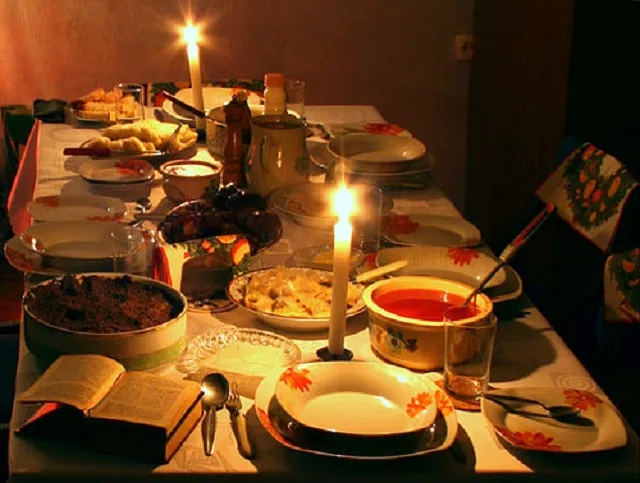Christmas is more than just a holiday — it’s a celebration of togetherness, gratitude, and tradition. Around the world, different cultures have their own unique ways of celebrating Christmas, but one of the most heartwarming and symbolic customs comes from the 12-dish Christmas dinner — a meal that’s deeply rooted in faith, family, and festive joy.
If you’ve ever wondered what the 12-dish Christmas dinner means, where it comes from, and what delicious dishes it includes, this article will take you on a flavorful journey through its history, meaning, and modern-day variations.
Read More:
- What is the best food in Christmas?
- What Is Traditional Christmas Food? A Festive Feast Around the World
- Christmas Food Ideas 2024
The Origins: A Feast of Faith and Tradition
The 12-dish Christmas dinner, also known as the Wigilia dinner in Poland and Sviata Vecheria in Ukraine, is a long-standing tradition that dates back centuries. It’s most popular in Central and Eastern Europe, though its symbolism resonates with Christians everywhere.
This meal isn’t just about indulgence — it’s steeped in religious symbolism and cultural meaning. Traditionally, the 12 dishes represent the 12 Apostles of Jesus, symbolizing unity, faith, and the blessings of the year. It’s a feast that brings families together to give thanks and remember the spiritual essence of Christmas.
A Little Historical Context
In Christian history, Christmas Eve (December 24) was often a day of fasting and abstinence, especially among Catholic and Orthodox communities. That meant no meat — which is why many of the 12 dishes are vegetarian or seafood-based. When the first star appears in the evening sky (symbolizing the Star of Bethlehem), families gather around the table to break their fast with this symbolic meal.
Every element — from the dishes to the table setting — carries deep meaning. Even the hay under the tablecloth, used in many Eastern European homes, represents the manger where Jesus was born.
The Spiritual Symbolism Behind the Number 12
Before we dive into the dishes themselves, it’s worth understanding why the number 12 is so important.
- 12 Apostles of Jesus – representing faith and discipleship.
- 12 Months of the Year – symbolizing gratitude for the year’s blessings.
- 12 Tribes of Israel – connecting to biblical history and unity.
For many families, serving 12 dishes is a way of expressing thankfulness for abundance, hope for the new year, and honor to divine faith.
In some cultures, every guest is encouraged to at least taste all 12 dishes, to ensure good luck and prosperity for the coming year.
How the 12-Dish Christmas Dinner Is Served
Setting the Scene
The traditional Christmas Eve dinner often begins with the breaking of the opłatek — a thin wafer similar to communion bread — in Polish households. Family members share pieces of the wafer, exchange wishes for good health and happiness, and forgive past grievances.
Then comes the main feast, where 12 carefully prepared dishes await. The table is usually set with a white tablecloth, candles, and sometimes an extra place setting — reserved for an unexpected guest or to honor deceased loved ones. This symbolizes hospitality and remembrance, both key values of Christmas.
The Traditional 12 Dishes: A Symbolic and Delicious Feast
While every family and region has its own variation, here’s what a traditional 12-dish Christmas dinner might include — especially in countries like Poland, Lithuania, and Ukraine.
1. Barszcz (Beet Soup) with Uszka
A bright ruby-red beet soup, often served with tiny dumplings called uszka (meaning “little ears”), filled with mushrooms.
This soup represents love and warmth, and its color symbolizes life and vitality. It’s usually the first dish to open the meal — light, flavorful, and beautifully festive.
2. Pierogi (Stuffed Dumplings)
Pierogi are small, crescent-shaped dumplings stuffed with various fillings like potato and cheese, mushrooms and cabbage, or fruit for a sweet version.
They represent prosperity and hard work, reflecting the effort that goes into preparing them. Every bite feels like comfort — soft dough wrapping around familiar holiday flavors.
3. Herring (Śledź) in Oil or Cream
Herring appears in many forms — pickled, marinated, or served with sour cream and onions.
Because fish swim in schools, they symbolize unity and abundance. In older times, fish was also a humble reminder of fasting before Christmas Day’s meat feast.
4. Carp — The Main Fish Dish
In Eastern Europe, carp is often the centerpiece of the Christmas Eve meal. It’s served fried, baked, or in aspic (a jelly-like broth).
Traditionally, carp scales are kept in wallets for good fortune, believed to bring wealth in the coming year.
5. Cabbage with Mushrooms
A hearty and earthy dish of braised cabbage and wild mushrooms, representing fertility and the richness of the earth.
The dish is often slow-cooked to develop deep, comforting flavors, pairing perfectly with pierogi or potatoes.
6. Kutia or Kūčia (Sweet Grain Pudding)
This ancient dish, especially popular in Ukraine and Lithuania, is made from wheat berries, honey, nuts, and poppy seeds.
It’s sweet, sticky, and symbolic — representing unity, immortality, and the connection between the living and the departed. Some families even leave a bowl out for ancestors.
7. Kompot (Dried Fruit Drink)
A refreshing, naturally sweet beverage made by simmering dried fruits like prunes, apples, and apricots.
It’s often served cold and symbolizes hope and renewal — a healthy contrast to the rich foods of the table.
8. Potato Pancakes (Placki Ziemniaczane)
Crispy and golden, these savory pancakes made of grated potatoes are a fan favorite.
They represent hard work and perseverance, as potatoes were once the backbone of rural diets.
9. Sauerkraut with Peas
Tangy sauerkraut combined with peas provides a hearty, fiber-rich dish that pairs beautifully with fried fish or pierogi.
It symbolizes humility and simplicity, honoring the agricultural roots of many Christmas traditions.
10. Poppy Seed Roll (Makowiec)
This delicious pastry filled with poppy seeds and honey represents wealth and peaceful dreams.
Poppy seeds, with their abundance of tiny grains, symbolize prosperity — the more you eat, the more luck you’ll have in the new year!
11. Bread and Honey
Bread, the staff of life, is a must-have on the table — often paired with honey, symbolizing health, sweetness, and divine blessings.
In many homes, bread is shared before the main meal as a symbol of unity.
12. Mushroom Soup or Cabbage Rolls
To round out the twelve, many families add mushroom soup or stuffed cabbage rolls (gołąbki).
Both dishes represent nourishment and tradition, often seasoned with garlic and herbs for a comforting finish to the meal.
Regional Variations of the 12-Dish Christmas Dinner
While the concept of 12 symbolic dishes is common, the exact menu varies from country to country — and even family to family.
🇵🇱 Poland – Wigilia
Polish families follow the most well-known version of the 12-dish tradition. The Wigilia meal begins when the first star appears, followed by the sharing of the opłatek wafer, prayers, and carol singing. Meat is absent, but fish, dumplings, and sweet rolls fill the table.
🇺🇦 Ukraine – Sviata Vecheria
Ukrainian families celebrate with dishes like kutia, borscht, varenyky (dumplings), and holubtsi (cabbage rolls). The dinner begins only after the first star appears, and a candle is lit to represent the birth of Christ.
🇱🇹 Lithuania – Kūčios
Lithuania’s Christmas Eve dinner also features 12 dishes, including herring, mushrooms, beetroot salad, and grain pudding. An extra seat is left for ancestors, and no alcohol is served — the focus is spiritual reflection.
🇧🇾 Belarus & 🇷🇺 Russia – Holy Supper
In Orthodox Christian homes, especially in Belarus and Russia, the 12 dishes are served on January 6, aligning with the Julian calendar. The spread includes lentil soup, pancakes, vegetable salads, and steamed fish.
Modern Adaptations: Blending Tradition with Taste
In today’s world, many families adapt the 12-dish dinner to suit their lifestyles and tastes.
While the spiritual symbolism remains, the dishes often reflect local ingredients or global influences.
Some modern touches include:
- Vegan or vegetarian options – using plant-based alternatives for traditional dishes.
- Fusion dishes – like sushi rolls or pasta included among the twelve.
- Dessert variety – from chocolate cakes to cookies, representing the sweet moments of family life.
The essence, however, is unchanged — a celebration of faith, food, and family.
The Emotional Side of the 12-Dish Christmas Dinner
What makes the 12-dish Christmas dinner so magical isn’t just the food — it’s the feeling it creates.
It’s the quiet anticipation of that first star appearing in the sky.
The clinking of glasses as family members exchange heartfelt wishes.
The smell of warm beet soup and baked bread filling the home.
And perhaps most importantly, the sense of connection — to each other, to tradition, and to something greater than ourselves.
In a world that moves faster than ever, these moments of stillness and gratitude remind us what truly matters.
How to Create Your Own 12-Dish Christmas Dinner
You don’t need to be Polish, Ukrainian, or Lithuanian to embrace this beautiful tradition.
If you’d like to start your own version of a 12-dish Christmas dinner, here’s how:
- Plan the menu early. Choose a mix of savory and sweet dishes — you can stick to tradition or customize with local flavors.
- Include symbolic meaning. Each dish should represent something — love, peace, abundance, or family unity.
- Make it a shared effort. Have each family member prepare or contribute a dish — it’s a great bonding experience.
- Set the mood. Light candles, play carols, and keep the table simple yet elegant.
- Share gratitude. Before eating, go around the table and let everyone share one thing they’re thankful for.
You can even create a fusion-style 12-dish dinner, blending traditional Eastern European recipes with your local cuisine — for example:
- Beet soup alongside roasted vegetables
- Pierogi-inspired dumplings filled with local spices
- Sweet puddings or cakes as symbolic desserts
Why the 12-Dish Christmas Dinner Still Matters Today
In an age where convenience often replaces ritual, the 12-dish Christmas dinner stands as a powerful reminder of connection and gratitude.
It invites us to slow down, cook with love, and appreciate the presence of those around us.
It’s not just about food — it’s about heritage, community, and storytelling.
Each dish tells a tale — of ancestors, of faith, of resilience through winters and wars, and of the timeless joy of sharing a meal together.
Final Thoughts
The 12-dish Christmas dinner is far more than a feast — it’s a living symbol of faith, hope, and family unity. Whether you follow it exactly as tradition dictates or create your own modern twist, the meaning remains: to gather, to share, and to give thanks.
So this Christmas, as you sit down to your own festive table, think of the 12-dish dinner not just as a cultural custom — but as a heartfelt reminder that the true spirit of Christmas isn’t measured by how much we eat, but by how deeply we connect.


